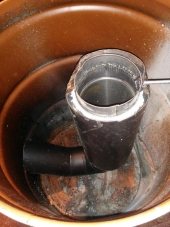posted 11 years ago
Matthew Weir : Their are more than a few Technical problems with the build recorded within the video, I will attempt to list most of them.
Be advised that the tears in my eyes as I attempted to watch this probably caused me to miss a few errors in the unit we see built !
As a proof of concept build it was a success! Otherwise, the builders quickly fell into error and never recovered. To err is human, and I am
human, but not as willing to show certain lack of understanding of the concepts willingly to my peers!
For a proof of concept exercise the use of iron/steel in the Feed tube and Burn Tunnel and Heat Riser is acceptable ONLY when it is
announced for all gathered, and all that will see this video that this is a temporary build that will quickly fail as made! Many people watching
this will now falsely believe that iron and steel can be used in these locations, this is completely false, as has been repeatedly shown !
The use of sand to make-up the thickness of the Heat Riser is totally inadequate, and when the 8'' pipe that makes up the inner wall of the
Heat Riser fails the sand will pour down into the burn tunnel, probably while the unit is being used, filling the room with smoke and the Feed
Tube with flames !
The Barrel in question is a 16-18 gal grease drum for lubing cars and light trucks, you should be able to get one at at Oil change shops,
muffler, and brake repair shop chains!
Both the grease drum and the 55 gal drum need to have the paint removed, I still prefer burning it off and also changing the way the
galvanizing is bonded to the 1st 4-8 feet of the galvanized pipe used within the horizontal pipe run through the Thermal Mass !
The Transitional area where the vertically falling gases meet the opening into the Thermal Mass is inadequately small the opening should be
3xs the size as shown in the video, gently sweeping the hot exhaust gases as they turn their 90 degrees to flow though the Thermal mass !
Stated in the demonstration was the material used to hold the bricks together was 'cement' generally this would be a sign that the material
was a Portland Cement based Mortar, this is the wrong material to use on a Rocket Mass Heater RMH, it should be a Clay sand based Mortar!
As shown the rocks placed on ether see of the horizontally run pipe probably performed a function to stabilize the pipe! I like to use short
sheet metal screws, at least two at every joint ! The proper use of the rocks in question would be to increase the density and heat handling
characteristics of the thermal mass this also greatly reduces the amount of 'Cob' that must be made !
Here again sand is just not the material to use at this location.
At 5:25 In the video the builder states that the drum is to tall for the Heat Riser, and we are shown that the drum has been cut down! This
seems to work- but the more efficient solution is to raise the height of the Heat riser to with in 2'' to 2.5'' of the underside of the drum, Raising
the Heat Riser has the additional benefit of improving its ability to draft ! Occasionally a gap 3'' or bigger has proved to help!
the final vertical chimney was never plumbed to the outside of the building -ending some 4' over the peak of the roof, a storm cap is always a
good idea !
The use of galvanized roofing as shown in the video must have been a preexisting installation to keep dripping water off of the roof of the
g'house from creating standing puddles on the wood, as a source of protection from high temperature heat loads the roofing would not have
Helped those wooden exposures at all!
I now have a headache and need to lie down, Let me close by saying there is a LOT OF CRAP on You-tube ! For the crafts Big AL
Success has a Thousand Fathers , Failure is an Orphan
LOOK AT THE " SIMILAR THREADS " BELOW !

































































